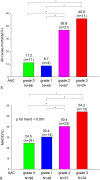Aortic Arch Calcification Associated with Cardiovascular Events and Death among Patients with Acute Coronary Syndrome
- PMID: 28559654
- PMCID: PMC5445241
- DOI: 10.6515/acs20160902a
Aortic Arch Calcification Associated with Cardiovascular Events and Death among Patients with Acute Coronary Syndrome
Abstract
Background: To date, it remains unsettled whether aortic arch calcification (AAC) has prognostic value in patients with acute coronary syndrome.
Methods: From January 1 to December 31, 2013, a total of 225 patients with acute coronary syndrome (mean age 72 ± 26 years, 75% male) were enrolled in this study. Patients admitted to the coronary care unit of a tertiary referral medical center under the preliminary diagnosis of acute coronary syndrome were retrospectively investigated. The primary endpoint was composite of long-term major adverse cardiovascular events. The secondary endpoints were 30-day and long-term all-cause mortality.
Results: Of the 225 patients enrolled in this study, 143 had detectable AAC. Those who had AAC were older, with higher Killip classification and thrombolysis in myocardial infarction (TIMI) score with a lower probability of single vessel disease. Acute coronary syndrome patients with AAC had significantly higher 30-day mortality (17.3% vs. 7.1%, log-rank p = 0.02). During a mean follow-up period of 165 ± 140 days (maximum 492 days), the calcification group had significantly increased cardiovascular deaths (27.6% vs. 11.2%, log-rank p = 0.002), all-cause mortality (28.3% vs. 11.2%, log-rank p = 0.001) and composite endpoint of major adverse cardiovascular events (39.4% vs. 24.6%, log-rank p = 0.01). After adjusting for age, gender, diabetes mellitus and hypertension, AAC was an independent risk factor for primary and secondary endpoints among patients with acute coronary syndrome.
Conclusions: AAC provided valuable prognostic information on clinical outcomes in patients with acute coronary syndrome. However, different treatment strategies would be warranted for optimal risk reduction in such a population.
Keywords: Acute coronary syndrome; Aortic arch; Critical care; Thoracic radiography; Vascular calcification.
Figures




Similar articles
-
Aortic arch calcification detectable on chest X-ray is a strong independent predictor of cardiovascular events beyond traditional risk factors.Atherosclerosis. 2010 May;210(1):137-44. doi: 10.1016/j.atherosclerosis.2009.11.012. Epub 2009 Nov 17. Atherosclerosis. 2010. PMID: 20006335
-
Calcification of the aortic arch predicts cardiovascular and all-cause mortality in chronic hemodialysis patients.Cardiorenal Med. 2014 Apr;4(1):34-42. doi: 10.1159/000360230. Epub 2014 Mar 1. Cardiorenal Med. 2014. PMID: 24847332 Free PMC article.
-
Coronary artery calcification outperforms thoracic aortic calcification for the prediction of myocardial infarction and all-cause mortality: the Heinz Nixdorf Recall Study.Eur J Prev Cardiol. 2014 Sep;21(9):1163-70. doi: 10.1177/2047487313482281. Epub 2013 Mar 6. Eur J Prev Cardiol. 2014. PMID: 23467675
-
Presence of abdominal aortic calcification is significantly associated with all-cause and cardiovascular mortality in maintenance hemodialysis patients.Am J Kidney Dis. 2007 Mar;49(3):417-25. doi: 10.1053/j.ajkd.2006.12.017. Am J Kidney Dis. 2007. PMID: 17336703
-
Role of cardiovascular magnetic resonance in acute coronary syndrome.Glob Cardiol Sci Pract. 2015 Jul 2;2015(2):24. doi: 10.5339/gcsp.2015.24. eCollection 2015. Glob Cardiol Sci Pract. 2015. PMID: 26779508 Free PMC article. Review. No abstract available.
Cited by
-
Association between acute aortic dissection and the distribution of aortic calcification.PLoS One. 2019 Jul 11;14(7):e0219461. doi: 10.1371/journal.pone.0219461. eCollection 2019. PLoS One. 2019. PMID: 31295298 Free PMC article.
-
Predictive value of abdominal aortic calcification index for mid-term cardiovascular events in patients with acute coronary syndrome.Heart Vessels. 2020 May;35(5):620-629. doi: 10.1007/s00380-019-01527-6. Epub 2019 Nov 9. Heart Vessels. 2020. PMID: 31707516
-
Predictive performance of aortic arch calcification for clinical outcomes in patients with acute coronary syndrome that undergo percutaneous coronary intervention: A prospective clinical study.Medicine (Baltimore). 2019 Nov;98(48):e18187. doi: 10.1097/MD.0000000000018187. Medicine (Baltimore). 2019. PMID: 31770274 Free PMC article.
-
The Relationship between Heart Rate Variability and Aortic Knob Width.Korean J Fam Med. 2019 Jan;40(1):39-44. doi: 10.4082/kjfm.18.0077. Epub 2019 Jan 9. Korean J Fam Med. 2019. PMID: 30625270 Free PMC article.
-
Multimodal Cardiac Imaging in the Assessment of Patients Who Have Suffered a Cardioembolic Stroke: A Review.J Cardiovasc Dev Dis. 2023 Dec 31;11(1):13. doi: 10.3390/jcdd11010013. J Cardiovasc Dev Dis. 2023. PMID: 38248883 Free PMC article. Review.
References
-
- Witteman JC, Kannel WB, Wolf PA, et al. Aortic calcified plaques and cardiovascular disease (the framingham study). Am J Cardiol. 1990;66:1060–1064. - PubMed
-
- Witteman JC, Kok FJ, van Saase JL, et al. Aortic calcification as a predictor of cardiovascular mortality. Lancet. 1986;2:1120–1122. - PubMed
-
- Yamamoto H, Shavelle D, Takasu J, et al. Valvular and thoracic aortic calcium as a marker of the extent and severity of angiographic coronary artery disease. Am Heart J. 2003;146:153–159. - PubMed
-
- Detrano R, Guerci AD, Carr JJ, et al. Coronary calcium as a predictor of coronary events in four racial or ethnic groups. N Engl J Med. 2008;358:1336–1345. - PubMed
LinkOut - more resources
Full Text Sources
